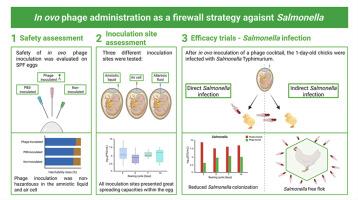蛋清噬菌体管理以减轻肉仔鸡鼠伤寒沙门氏菌定植-家禽业的新防火墙策略
IF 6.3
1区 农林科学
Q1 FOOD SCIENCE & TECHNOLOGY
引用次数: 0
摘要
孵化场作为家禽生产管道的初始阶段,在沙门氏菌的潜在传播中起着关键作用。工业化家禽生产的高密度饲养条件,加上雏鸡从孵化场常规转移到多个养殖场,增加了病原体在广泛地理区域传播的可能性。因此,有必要制定符合监管要求并有效针对致病性威胁的创新消毒战略。在此背景下,本研究旨在评估在蛋鸡中应用噬菌体作为预防措施以减少沙门氏菌从孵化场传播到养殖场的安全性和有效性。为此,进行了两个实验。实验1评估了卵细胞中最安全、最有效的噬菌体接种部位,实验2测试了直接和间接接触后,通过羊水给药的噬菌体鸡尾酒在孵育后21天内减少鼠伤寒沙门菌定植的效果。结果表明,在卵接种部位,羊水中给药是最安全、最合适的。此外,噬菌体处理显著减少了沙门氏菌在直接感染雏鸡中的定植,并完全阻止了间接感染雏鸡的传播。在鸡蛋管理噬菌体被证明是一个有前途的预防性防火墙策略,以限制沙门氏菌在生产链内的传播。本文章由计算机程序翻译,如有差异,请以英文原文为准。

In ovo phage administration to mitigate Salmonella Typhimurium colonization in broiler chickens – A new firewall strategy for the poultry industry
Hatcheries, as the initial stage of the poultry production pipeline, play a pivotal role in the potential spread of Salmonella. The high-density rearing conditions of industrial poultry production, coupled with the routine transfer of chicks from hatcheries to multiple farm locations, heighten the likelihood of pathogen dissemination across wide geographic areas. Therefore, there is a need for innovative disinfection strategies that align with regulatory requirements and effectively target pathogenic threats. In this context, this study aimed to assess the safety and efficacy of bacteriophages application in ovo as a preventive measure to mitigate Salmonella transmission from hatcheries to the rearing farms. To do so, two experiments were conducted. Experiment 1 evaluated the safest and most effective in ovo inoculation site for phage delivery, while the Experiment 2 tested the efficacy of a phage cocktail administered via the amniotic liquid in reducing Salmonella Typhimurium colonization during the first 21 days post-hatch after direct and indirect exposure. The results demonstrated that phage administration in the amniotic liquid was the safest and most suitable in ovo inoculation site. Furthermore, phage treatment significantly reduced Salmonella colonization in directly infected chicks and completely prevented transmission in indirectly exposed birds. In ovo administration of the phages proved to be a promising prophylactic firewall strategy to limit the spread of Salmonella within the production chain.
求助全文
通过发布文献求助,成功后即可免费获取论文全文。
去求助
来源期刊

Food Control
工程技术-食品科技
CiteScore
12.20
自引率
6.70%
发文量
758
审稿时长
33 days
期刊介绍:
Food Control is an international journal that provides essential information for those involved in food safety and process control.
Food Control covers the below areas that relate to food process control or to food safety of human foods:
• Microbial food safety and antimicrobial systems
• Mycotoxins
• Hazard analysis, HACCP and food safety objectives
• Risk assessment, including microbial and chemical hazards
• Quality assurance
• Good manufacturing practices
• Food process systems design and control
• Food Packaging technology and materials in contact with foods
• Rapid methods of analysis and detection, including sensor technology
• Codes of practice, legislation and international harmonization
• Consumer issues
• Education, training and research needs.
The scope of Food Control is comprehensive and includes original research papers, authoritative reviews, short communications, comment articles that report on new developments in food control, and position papers.
 求助内容:
求助内容: 应助结果提醒方式:
应助结果提醒方式:


